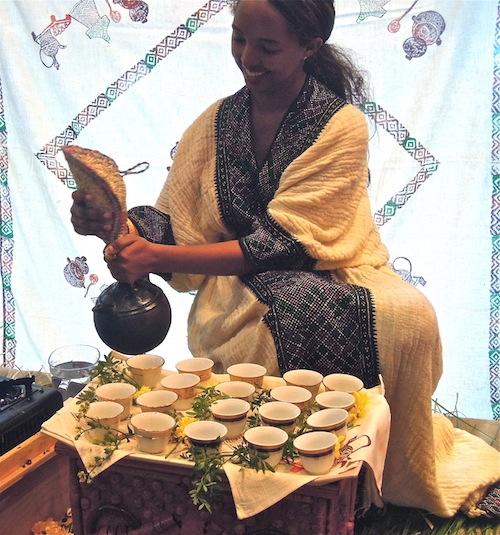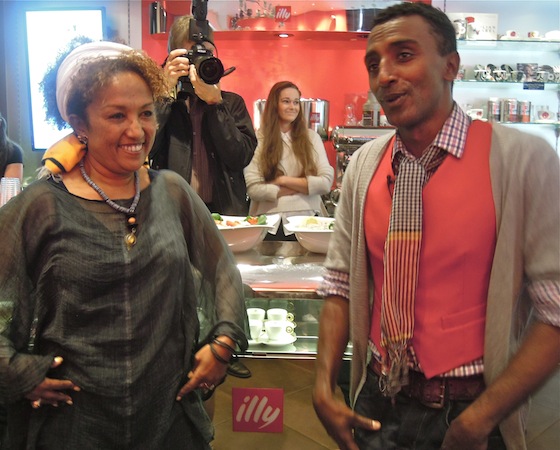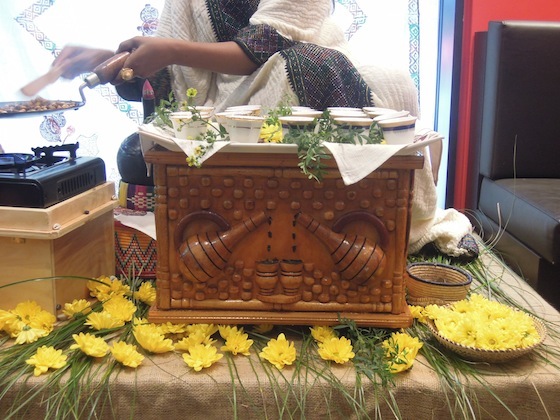Ethiopian-born Samuelsson, who grew up in a loving adoptive family in Sweden after becoming an orphan at an early age, returned to Ethiopia only twelve years ago. He is an enthusiastic supporter of authentic ethnic culture for its “tradition, value and meaning.” Samuelsson adds,
"The way to understand a culture is to know what they eat and drink. I didn’t know very much about the Ethiopian coffee ritual when I visited Ethiopia, but now I want to introduce a friend who knows everything.”
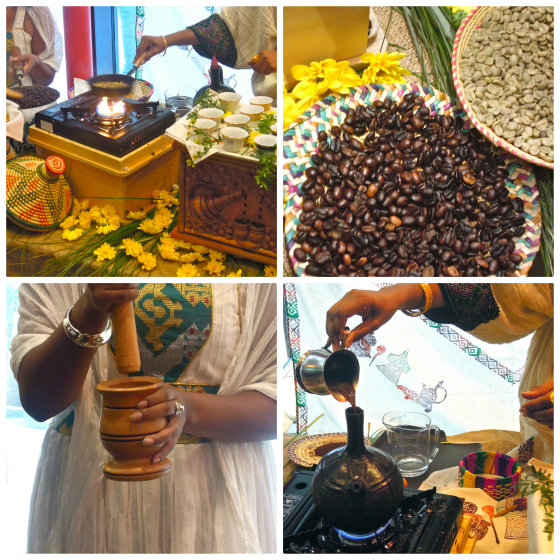
Roasting, grinding and brewing coffee, the Ethiopian way
So Fetlework Tefferi of Oakland’s award-winning Café Colucci takes a bowl with lighted incense and gently waves it among the gathered visitors while a group of women from the East Bay Ethiopian community who work with Tefferi begin to roast the green coffee beans. Two ways of roasting the beans are demonstrated: stirring them on a flat bottomed pan or shaking them in a shallow pan until they sweat and turn a shiny dark brown, being careful not to let them burn. The hot roasted beans are poured onto a flat basket to cool and then passed around so the crowd can appreciate their deep, rich aroma. The next step in the ritual, as narrated by Tefferi, is grinding the cooled beans by hand with a wooden mortar and pestle.
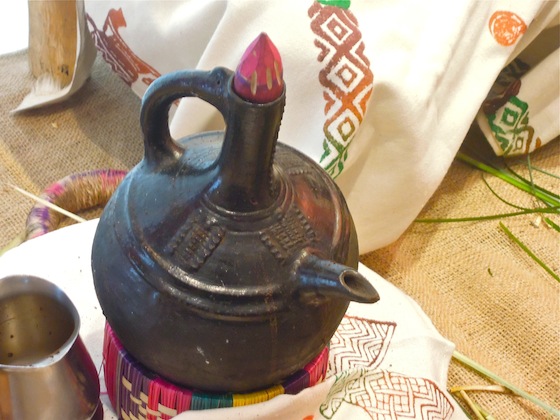
Traditional Ethiopian clay jebena coffee pot
The ground coffee is then boiled with water in a special long–necked, handmade, black clay pot, called a jebena, which Samuelsson remembers seeing sold by artisans in markets on his trips to Ethiopia. When the brew is judged to be ready (which may necessitate some back and forth decanting from the jebena into another vessel), the finished coffee is poured from the jebena held high above a tray of cups, which are then passed around the crowd. Samuelsson advises that this coffee is best drunk black, the better to notice the hints of lavender, citrus and blueberry. As one who usually takes my mug with plenty of milk and sugar, I am delightfully surprised at the smooth, velvety brew. Tefferi adds that in Ethiopia some people may add salt or spiced butter to their coffee. Snacks, such as roasted barley, peanuts, or popcorn are typically eaten with the coffee and a basket of barley and seeds is also passed around the room.
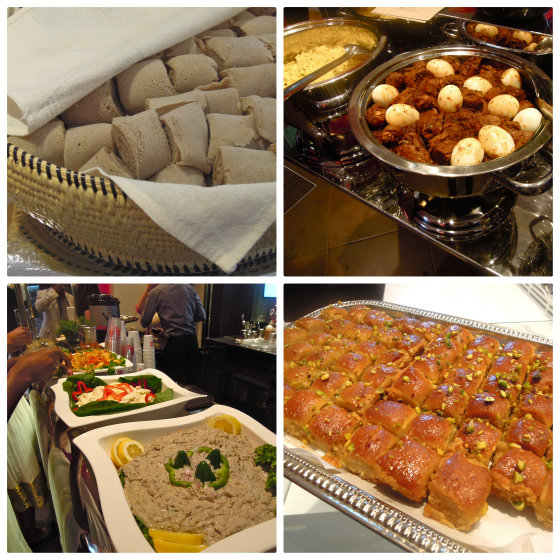
Rolls of injera, doro wot with eggs, buffet of azifa and buticha, baklava
After our coffee and roasted barley, Tefferi introduces us to the waiting Ethiopian brunch specialties from her Oakland restaurant and its sister spice store Brundo that line the buffet: inkulal firfir (scrambled eggs with jalapenos and clarified butter), doro wot fitfit, chicken simmered in such a fiery berbere sauce that she cautions diners to be careful, homemade cheese, azifa (lavender hued soft cooked lentils with garlic, onions, lemon) and a pale yellow dish called buticha. “Americans tell me they dream about buticha," says Tefferi."People swear there's cream in it, but it's actually vegan and really seems to resonate with the America palate." I try the buticha and Tefferi is absolutely right. It's a creamy cloud of chickpea flour, olive oil, garlic and onions and a hint of jalapeno, the texture of soft-cooked scrambled eggs. Sweets include traditional dates and baklava-like pastries with pistachios or lavender. As a final touch, glasses of glowing-orange honey wine are handed out.
Ethiopian food is traditionally eaten by hand, served with rolls of injera (a crepe-like bread with which to pick up the meats and vegetables). Although forks are also provided for novice diners, Chef Samuelsson eats his doro wot appropriately by hand, making small bites in ripped off bits of injera.
To complete the hospitality, Ethiopian music fills the room and the women demonstrate a style of dancing where they shake their shoulders with the music. “I’ve been in Sweden too long,” quips Samuelsson, trying to keep up.
As things begin to wrap up, I look at my watch and see that it's only 11am, even though the event was billed to last until noon. Somehow the coffee ceremony seems to have sped by. So I ask Hiwot Tadesse, the woman who roasted the beans on the platorm, to explain a little more about how the ritual works in her native Ethiopia. "Is this something that happens only after dinner?" I ask.
She smiles and shakes her head. “Coffee happens two or three times a day, morning, noon and night. People leave their doors open and when someone starts to make coffee, the aroma circulates, effectively acting like an invitation for neighbors to drop over,” she explains. Ironically -- given our speeded up version -- the point of the Ethiopian coffee roasting ceremony is to slow down and take time to chat with friends and family about everything from politics to gossip. The entire ritual, I learn, may take a couple of hours from lighting incense, washing and drying the green coffee beans, roasting them in a special pan, passing them around to enjoy the aroma, grinding them, boiling them with water, then checking the brew by pouring out the liquid and pouring it back for more brewing. The full ceremony consists of serving three rounds of coffee, which each have a distinct name. The third cup is called baraka, which means blessing. Traditionally in Ethiopia, it is only women who make the coffee and part of the ritual is to praise their coffee making ability. Women in Ethiopian households invite family and neighbors for coffee, calling out “Buna Derswal!” (The Coffee is ready).
So the next time I dash in to grab a quick latte, I hope the sweet memories of this measured Ethiopian Coffee ritual will give me pause.
